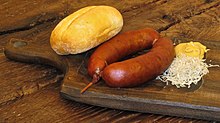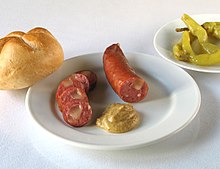Carniolan sausage

The Krainer Wurst ( Slovenian kranjska klobasa ) is a type of sausage that is widespread in large parts of Austria and Slovenia . The name comes from the historical region of Carniola in the former old Austria , in today's Slovenia.
Prescription and trademark protection
In 2012 Slovenia registered the name Kranjska Klobasa as a protected geographical indication (PGI). In Austria there were concerns that this protection would also extend to the traditional Austrian specialty. In a compromise, however, it was agreed that the German terms Krainer Wurst and Käsekrainer should continue to be permitted independently. However, these were not included in the list of traditional Austrian foods .
The sausage contains a coarse sausage meat consisting of at least 68% pork , 12% beef and a maximum of 20% bacon . The only allowed additives are 5% water , table salt, garlic and pepper . The meat must be cut into 10 to 13 mm pieces, the bacon into pieces 8 to 10 mm. The mass is filled into pig intestines with a diameter of 32 to 36 mm. Pairs 12 to 16 cm long and weighing 180 to 220 grams are formed. The pairs are put together with a wooden skewer, hot smoked and heat-treated at 70 degrees Celsius.
Variants and preparation
In a modification of the original recipe, Käsekrainer have a proportion of 10 to 20% cheese (e.g. Emmentaler ) in small cubes. They wereinventedin Austria in 1971 and are part of the standard range of sausage stands , especially in Vienna. Käsekrainer can be boiled, fried or grilled. They should not be pierced before preparation - otherwise the cheese will leak - and cook over a low heat so that the cheese does not burn. Cheese krainer should not be confused with Bernese sausages . In Viennese dialect , the käskrainer is also known as " purulent "because of the color of the hot cheesethat runs out. Cheese krainer are also served with mustard and freshly grated horseradish , in other versions with mustard and ketchup , optionallydustedwith curry powder. The Käsekrainer hot dog is very popular, in which a Käsekrainer is served in a hollowed-out piece of white bread with mustard and / or ketchup.
The Kransky is the oceanic version of the Slovenian original. It was "exported" by Slovenian emigrants in the late 1940s and 1950s and is now very popular in Australia and New Zealand . Over the years there have been a few variants of the Kransky, including the Cheese Kransky.
swell
-
↑ Publication of an application for approval of a minor amendment in accordance with Article 53 Paragraph 2 Subparagraph 2 of Regulation (EU) No. 1151/2012 of the European Parliament and of the Council 2015 / C 441/03 (as amended in German, online, EUR-Lex );
Application for the protection of the geographical indication (ibid.). - ↑ Purulent, the. In: Robert Sedlaczek, Reinhardt Badegruber: Viennese word stories: From plaster deer and winter swallows. Haymon Verlag, 2012, ISBN 978-3-7099-7538-1 , pp. OA (45 ff) ( limited preview in the Google book search.
- ↑ ended dispute: Käsekrainer remains Käsekrainer . In: Die Presse online, June 15, 2012 (accessed on January 10, 2013).
- ↑ Fast Food: Really fat. What is "healthier"? Burger, Burenwurst, Kebab or Käsekrainer? Profil 2007 (38), p. 118.
